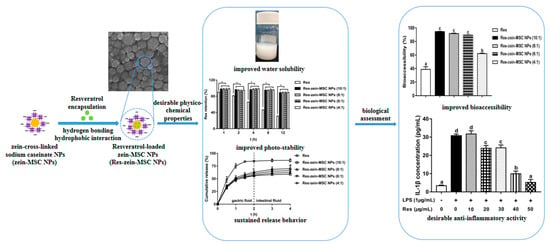A Novel Zein-Based Composite Nanoparticles for Improving Bioaccessibility and Anti-Inflammatory Activity of Resveratrol
Abstract
:1. Introduction
2. Materials and Methods
2.1. Chemicals
2.2. Preparation of Res-Zein-MSC NPs
2.3. Particle Size, Size Distribution and Zeta-Potential
2.4. Encapsulation Efficiency (EE)
2.5. Re-Dispersibility
2.6. Morphological Observations
2.7. ATR-FTIR
2.8. Fluorescence Spectroscopy
2.9. XRD
2.10. Photo-Stability
2.11. Release Behavior
2.12. Bioaccessibility
2.13. Cytotoxicity Assay
2.13.1. Cell Culture
2.13.2. MTT Assay
2.14. Anti-Inflammatory Activity
2.15. Statistical Analysis
3. Results and Discussion
3.1. Characterization of Res-Zein-MSC NPs
3.2. ATR-FTIR
3.3. Fluorescence Spectroscopy
3.4. XRD
3.5. Photo-Stability Study
3.6. Release Behavior
3.7. Bioaccessibility
3.8. Cytotoxicity Assay
3.9. Anti-Inflammatory Activity
4. Conclusions
Supplementary Materials
Author Contributions
Funding
Institutional Review Board Statement
Informed Consent Statement
Data Availability Statement
Conflicts of Interest
References
- Tsai, H.-Y.; Ho, C.-T.; Chen, Y.-K. Biological actions and molecular effects of resveratrol, pterostilbene, and 3′-hydroxypterostilbene. J. Food Drug Anal. 2017, 25, 134–147. [Google Scholar] [CrossRef] [PubMed] [Green Version]
- Lucas-Abellán, C.; Mercader-Ros, M.T.; Zafrilla, M.P.; Fortea, M.I.; Gabaldón, J.A.; Núñez-Delicado, E. ORAC-fluorescein assay to determine the oxygen radical absorbance capacity of resveratrol complexed in cyclodextrins. J. Agric. Food Chem. 2008, 56, 2254–2259. [Google Scholar] [CrossRef] [PubMed]
- Lee, J.-A.; Ha, S.K.; Cho, E.; Choi, I. Resveratrol as a bioenhancer to improve anti-inflammatory activities of apigenin. Nutrients 2015, 7, 9650–9661. [Google Scholar] [CrossRef] [PubMed] [Green Version]
- Xiong, W.F.; Ren, C.; Li, J.; Li, B. Enhancing the photostability and bioaccessibility of resveratrol using ovalbumin-carboxymethylcellulose nanocomplexes and nanoparticles. Food Funct. 2018, 9, 3788–3797. [Google Scholar] [CrossRef]
- Liu, Y.; Liang, X.; Zou, Y.; Peng, Y.Q.; McClements, D.J.; Hu, K. Resveratrol-loaded biopolymer core-shell nanoparticles: Bioavailability and anti-inflammatory effects. Food Funct. 2020, 11, 4014–4025. [Google Scholar] [CrossRef]
- Kotta, S.; Mubarak Aldawsari, H.; Badr-Eldin, S.M.; Alhakamy, N.A.; Md, S. Coconut oil-based resveratrol nanoemulsion: Optimization using response surface methodology, stability assessment and pharmacokinetic evaluation. Food Chem. 2021, 357, 129721. [Google Scholar] [CrossRef]
- Paliwal, R.; Palakurthi, S. Zein in controlled drug delivery and tissue engineering. J. Control. Release 2014, 189, 108–122. [Google Scholar] [CrossRef]
- Meng, R.; Wu, Z.; Xie, Q.-T.; Cheng, J.-S.; Zhang, B. Preparation and characterization of zein/carboxymethyl dextrin nanoparticles to encapsulate curcumin: Physicochemical stability, antioxidant activity and controlled release properties. Food Chem. 2021, 340, 127893. [Google Scholar] [CrossRef]
- Li, H.; Yuan, Y.K.; Zhu, J.X.; Wang, T.; Wang, D.F.; Xu, Y. Zein/soluble soybean polysaccharide composite nanoparticles for encapsulation and oral delivery of lutein. Food Hydrocoll. 2020, 103, 105715. [Google Scholar] [CrossRef]
- Wang, M.; Fu, Y.Y.; Chen, G.W.; Shi, Y.G.; Li, X.M.; Zhang, H.; Shen, Y.L. Fabrication and characterization of carboxymethyl chitosan and tea polyphenols coating on zein nanoparticles to encapsulate β-carotene by anti-solvent precipitation method. Food Hydrocoll. 2018, 77, 577–587. [Google Scholar] [CrossRef]
- Shukla, R.; Cheryan, M. Zein: The industrial protein from corn. Ind. Crop. Prod. 2001, 13, 171–192. [Google Scholar] [CrossRef]
- Wang, R.; Wang, Y.; Guo, W.; Zeng, M. Stability and bioactivity of carotenoids from Synechococcus sp. PCC 7002 in Zein/NaCas/Gum Arabic composite nanoparticles fabricated by pH adjustment and heat treatment antisolvent precipitation. Food Hydrocoll. 2021, 117, 106663. [Google Scholar] [CrossRef]
- Reboredo, C.; González-Navarro, C.J.; Martínez-Oharriz, C.; Martínez-López, A.L.; Irache, J.M. Preparation and evaluation of PEG-coated zein nanoparticles for oral drug delivery purposes. Int. J. Pharm. 2021, 597, 120287. [Google Scholar] [CrossRef] [PubMed]
- Zhang, Y.Q.; Niu, Y.G.; Luo, Y.C.; Ge, M.; Yang, T.; Yu, L.L.; Wang, Q. Fabrication, characterization and antimicrobial activities of thymolloaded zein nanoparticles stabilized by sodium caseinate-chitosan hydrochloride double layer. Food Chem. 2014, 142, 269–275. [Google Scholar] [CrossRef] [PubMed]
- Liu, Q.G.; Han, C.P.; Tian, Y.M.; Liu, T.Y. Fabrication of curcumin-loaded zein nanoparticles stabilized by sodium caseinate/sodium alginate: Curcumin solubility, thermal properties, rheology, and stability. Process Biochem. 2020, 94, 30–38. [Google Scholar] [CrossRef]
- Liu, J.P.; Zhang, Y.Q.; He, S.Z.; Zhou, A.M.; Gao, B.Y.; Yan, M.Y.; Yu, L.L. Microbial transglutaminase-induced cross-linking of sodium caseinate as the coating stabilizer of zein nanoparticles. LWT-Food Sci. Technol. 2021, 138, 110624. [Google Scholar] [CrossRef]
- Xue, J.L.; Zhang, Y.Q.; Huang, G.R.; Liu, J.; Slavin, M.; Yu, L.L. Zein-caseinate composite nanoparticles for bioactive delivery using curcumin as a probe compound. Food Hydrocoll. 2018, 83, 25–35. [Google Scholar] [CrossRef]
- Joye, I.J.; Davidov-Pardo, G.; Ludescher, R.D.; McClements, D.J. Fluorescence quenching study of resveratrol binding to zein and gliadin: Towards a more rational approach to resveratrol encapsulation using water-insoluble proteins. Food Chem. 2015, 185, 261–267. [Google Scholar] [CrossRef]
- Zhang, Y.Q.; Wang, B.; Wu, Y.; Gao, B.Y.; Yu, L.L. Fabrication and characterization of zein composite particles coated by caseinate-pectin electrostatic complexes with improved structural stability in acidic aqueous environments. Molecules 2019, 24, 2535. [Google Scholar] [CrossRef] [Green Version]
- Ritger, P.L.; Peppas, N.A. A simple equation for description of solute release I. Fickian and non-fickian release from non-swellable devices in the form of slabs, spheres, cylinders or discs. J. Control. Release 1987, 5, 23–36. [Google Scholar] [CrossRef]
- Sujja-Areevath, J.; Munday, D.L.; Cox, P.J.; Khan, K.A. Relationship between swelling, erosion and drug release in hydrophillic natural gum mini-matrix formulations. Eur. J. Pharm. Sci. 1998, 6, 207–217. [Google Scholar] [CrossRef]
- Chen, Y.F.; Xia, G.B.; Zhao, Z.L.; Xue, F.; Chen, C.; Zhang, Y. Formation, structural characterization, stability and: In vitro bioaccessibility of 7,8-dihydroxyflavone loaded zein-/sophorolipid composite nanoparticles: Effect of sophorolipid under two blending sequences. Food Funct. 2020, 11, 1810–1825. [Google Scholar] [CrossRef] [PubMed]
- Wei, Y.; Yang, S.F.; Zhang, L.; Dai, L.; Tai, K.D.; Liu, J.F.; Mao, L.K.; Yuan, F.; Gao, Y.X.; Mackie, A. Fabrication, characterization and in vitro digestion of food grade complex nanoparticles for co-delivery of resveratrol and coenzyme Q10. Food Hydrocoll. 2020, 105, 105791. [Google Scholar] [CrossRef]
- Fan, Y.T.; Liu, Y.X.; Gao, L.Y.; Zhang, Y.Z.; Yi, J. Improved chemical stability and cellular antioxidant activity of resveratrol in zein nanoparticle with bovine serum albumin-caffeic acid conjugate. Food Chem. 2018, 261, 283–291. [Google Scholar] [CrossRef] [PubMed]
- Fang, Z.; Cai, X.; Wu, J.; Zhang, L.; Fang, Y.; Wang, S. Effect of simultaneous treatment combining ultrasonication and pH-shifting on SPI in the formation of nanoparticles and encapsulating resveratrol. Food Hydrocoll. 2021, 111, 106250. [Google Scholar] [CrossRef]
- Su, H.X.; Huang, C.X.; Liu, Y.; Kong, S.; Wang, J.; Huang, H.H.; Zhang, B.B. Preparation and characterization of cinnamomum essential oil-chitosan nanocomposites: Physical, structural, and antioxidant activities. Processes 2020, 8, 834. [Google Scholar] [CrossRef]
- Shi, Y.N.; Ye, F.; Lu, K.Y.; Hui, Q.R.; Miao, M. Characterizations and Bioavailability of Dendrimer-like Glucan Nanoparticulate System Containing Resveratrol. J. Agric. Food Chem. 2020, 68, 6420–6429. [Google Scholar] [CrossRef]
- Chen, S.; Ma, Y.; Dai, L.; Liao, W.; Zhang, L.; Liu, J.; Gao, Y. Fabrication, characterization, stability and re-dispersibility of curcumin-loaded gliadin-rhamnolipid composite nanoparticles using pH-driven method. Food Hydrocoll. 2021, 118, 106758. [Google Scholar] [CrossRef]
- Rufier, C.; Reufer, M.; Dietsch, H.; Schurtenberger, P. Single step hybrid coating process to enhance the electrosteric stabilization of inorganic particles. Langmuir 2011, 27, 6622–6627. [Google Scholar] [CrossRef] [Green Version]
- Qin, L.; Zhao, X.; He, Y.; Wang, H.; Wei, H.; Zhu, Q.; Zhang, T.; Qin, Y.; Du, A. Preparation, characterization, and in vitro evaluation of resveratrol-loaded cellulose aerogel. Materials 2020, 13, 1624. [Google Scholar] [CrossRef] [Green Version]
- Wei, Y.; Yu, Z.P.; Lin, K.S.; Sun, C.X.; Dai, L.; Yang, S.F.; Mao, L.K.; Yuan, F.; Gao, Y.X. Fabrication and characterization of resveratrol loaded zein-propylene glycol alginate-rhamnolipid composite nanoparticles: Physicochemical stability, formation mechanism and in vitro digestion. Food Hydrocoll. 2019, 95, 336–348. [Google Scholar] [CrossRef]
- Mohammadi, M.; Shareghi, B.; Farhadian, S.; Saboury, A.A. The effect of sorbitol on the structure and activity of carboxypeptidase A: Insights from a spectroscopic and computational approach. J. Mol. Liq. 2021, 330, 115710. [Google Scholar] [CrossRef]
- Ren, G.Y.; Sun, H.; Guo, J.Y.; Fan, J.L.; Li, G.; Xu, S.W. Molecular mechanism of the interaction between resveratrol and trypsin: Via spectroscopy and molecular docking. Food Funct. 2019, 10, 3291–3302. [Google Scholar] [CrossRef] [PubMed]
- Khan, M.A.; Yue, C.; Fang, Z.; Hu, S.S.; Cheng, H.; Bakry, A.M.; Liang, L. Alginate/chitosan-coated zein nanoparticles for the delivery of resveratrol. J. Food Eng. 2019, 258, 45–53. [Google Scholar] [CrossRef]
- Liu, Y.X.; Fan, Y.T.; Gao, L.Y.; Zhang, Y.Z.; Yi, J. Enhanced pH and thermal stability, solubility and antioxidant activity of resveratrol by nanocomplexation with α-lactalbumin. Food Funct. 2018, 9, 4781–4790. [Google Scholar] [CrossRef]
- Navarro, G.; Martínez-Pinilla, E.; Ortiz, R.; Noé, V.; Ciudad, C.J.; Franco, R. Resveratrol and Related Stilbenoids, Nutraceutical/Dietary Complements with Health-Promotin Actions: Industrial Production, Safety, and the Search for Mode of Action. Compr. Rev. Food Sci. Food Saf. 2018, 17, 808–826. [Google Scholar] [CrossRef] [Green Version]
- Zhang, L.; Zhang, F.; Fang, Y.; Wang, S. Alginate-shelled SPI nanoparticle for encapsulation of resveratrol with enhanced colloidal and chemical stability. Food Hydrocoll. 2019, 90, 313–320. [Google Scholar] [CrossRef]
- Wu, W.H.; Kong, X.Z.; Zhang, C.M.; Hua, Y.F.; Chen, Y.M.; Li, X.F. Fabrication and characterization of resveratrol-loaded gliadin nanoparticles stabilized by gum Arabic and chitosan hydrochloride. LWT-Food Sci. Technol. 2020, 129, 109532. [Google Scholar] [CrossRef]
- Flores, F.P.; Kong, F.B. In vitro release kinetics of microencapsulated materials and the effect of the food matrix. Annu. Rev. Food Sci. Technol. 2017, 8, 237–259. [Google Scholar] [CrossRef]
- Abriata, J.P.; Eloy, J.O.; Riul, T.B.; Campos, P.M.; Baruffi, M.D.; Marchetti, J.M. Poly-epsilon-caprolactone nanoparticles enhance ursolic acid in vivo efficacy against Trypanosoma cruzi infection. Mater. Sci. Eng. C-Mater. Biol. Appl. 2017, 77, 1196–1203. [Google Scholar] [CrossRef]
- Nunes, R.; Baião, A.; Monteiro, D.; das Neves, J.; Sarmento, B. Zein nanoparticles as low-cost, safe, and effective carriers to improve the oral bioavailability of resveratrol. Drug Deliv. Transl. Res. 2020, 10, 826–837. [Google Scholar] [CrossRef] [PubMed]
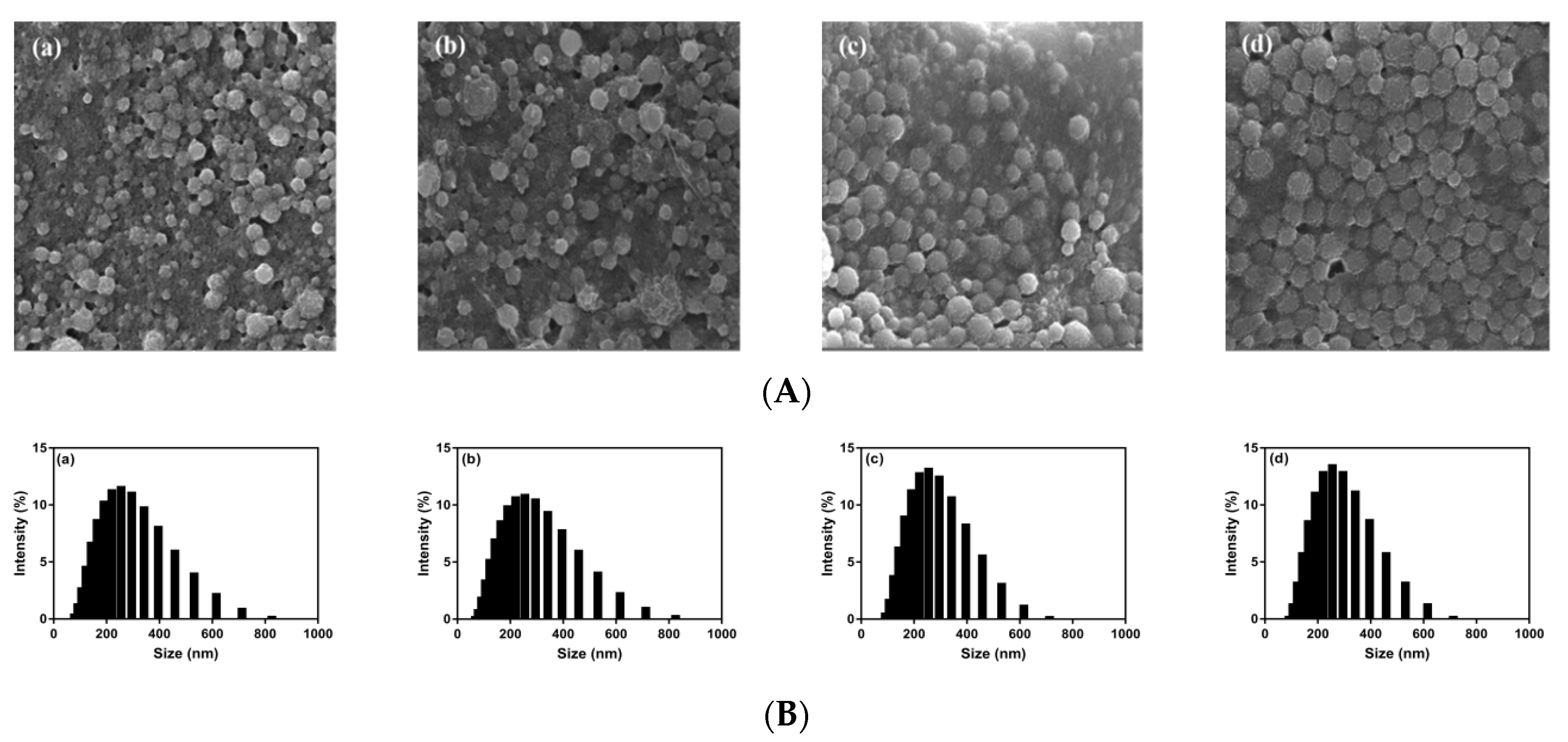
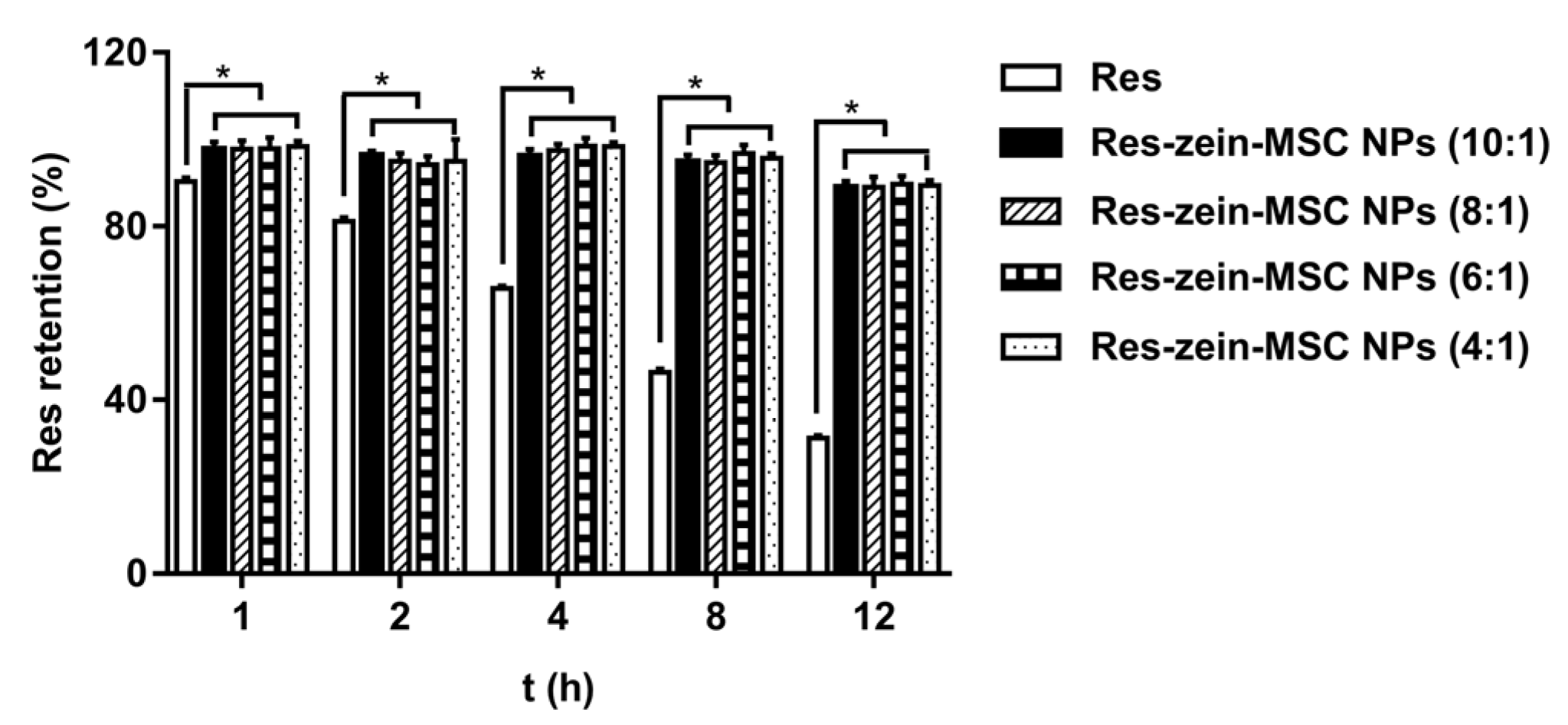

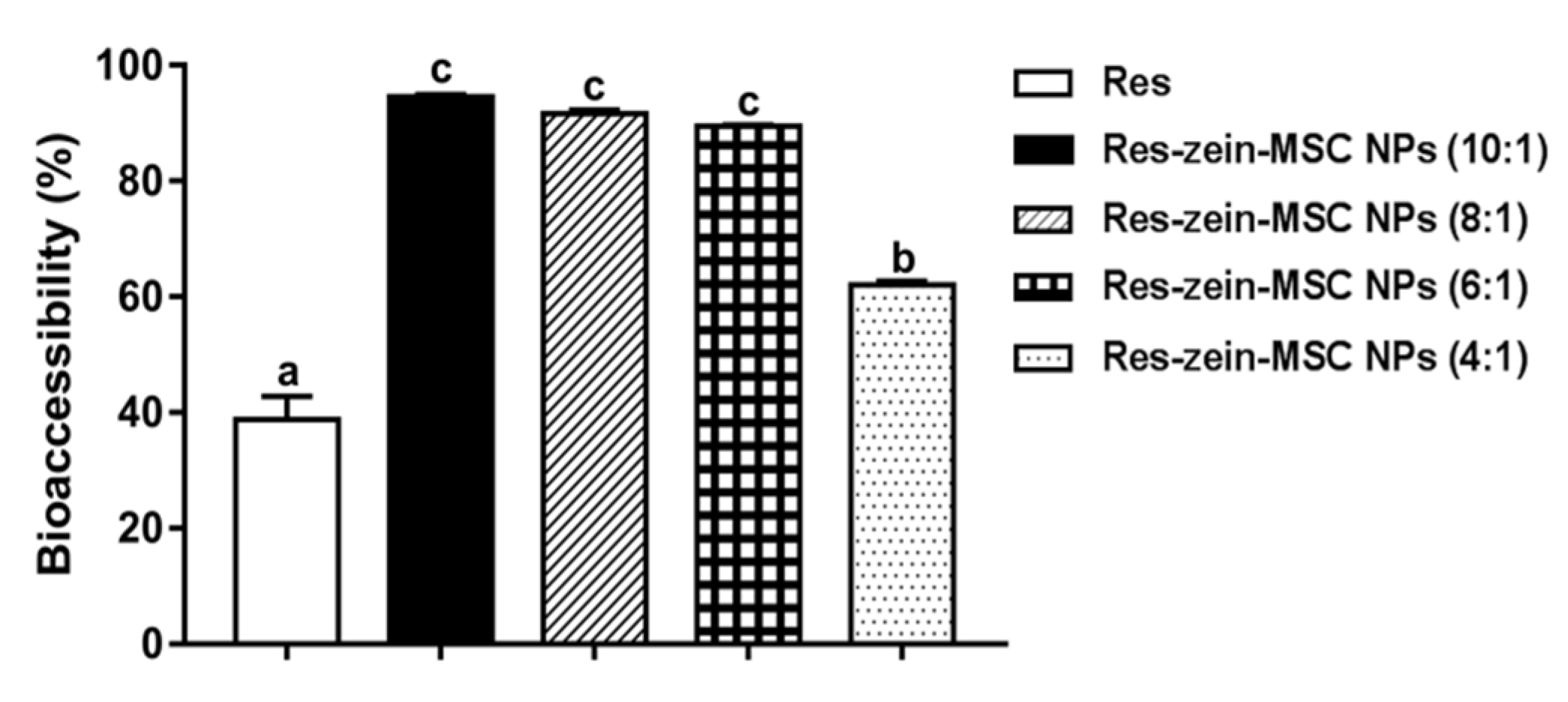
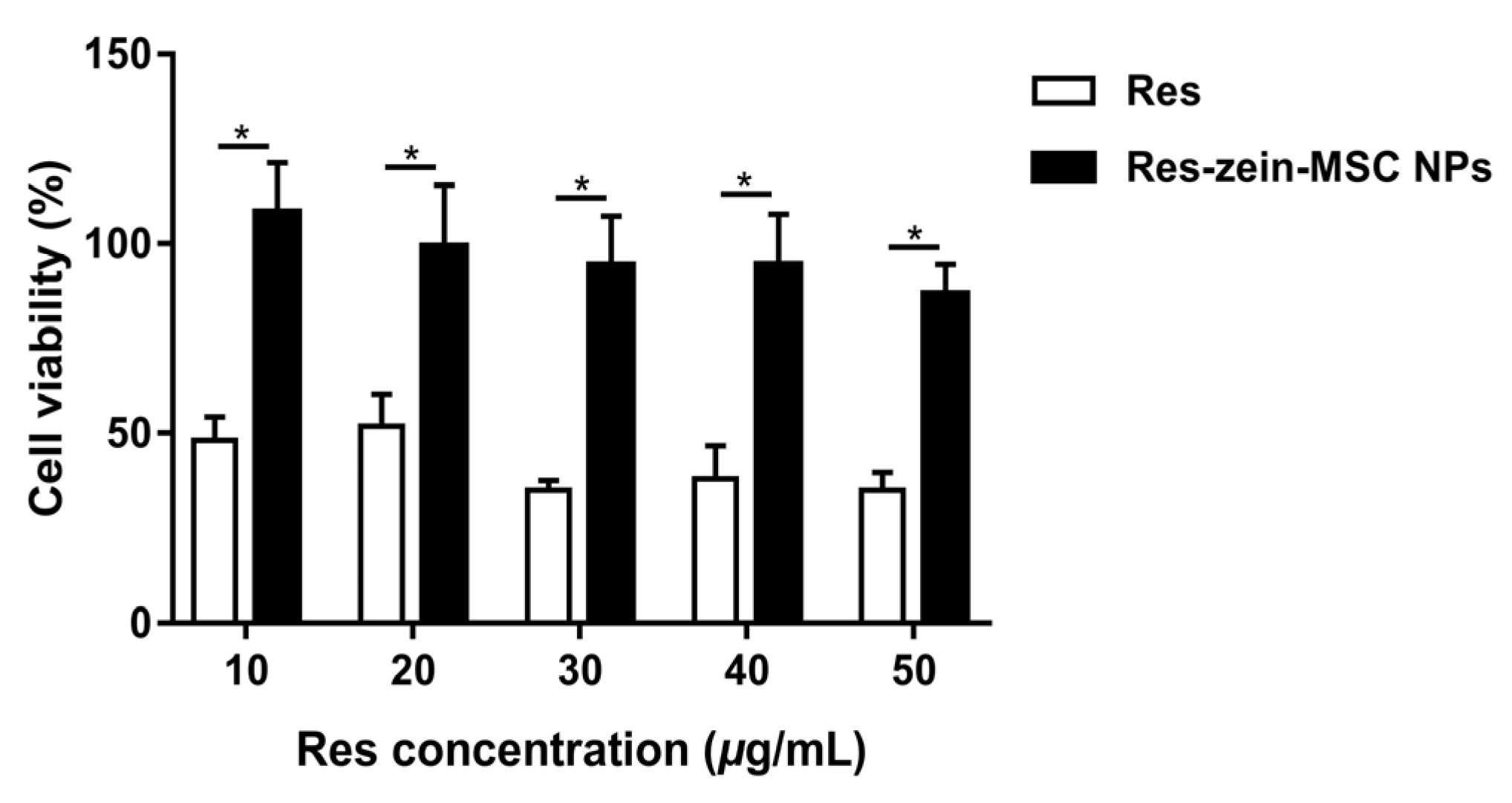
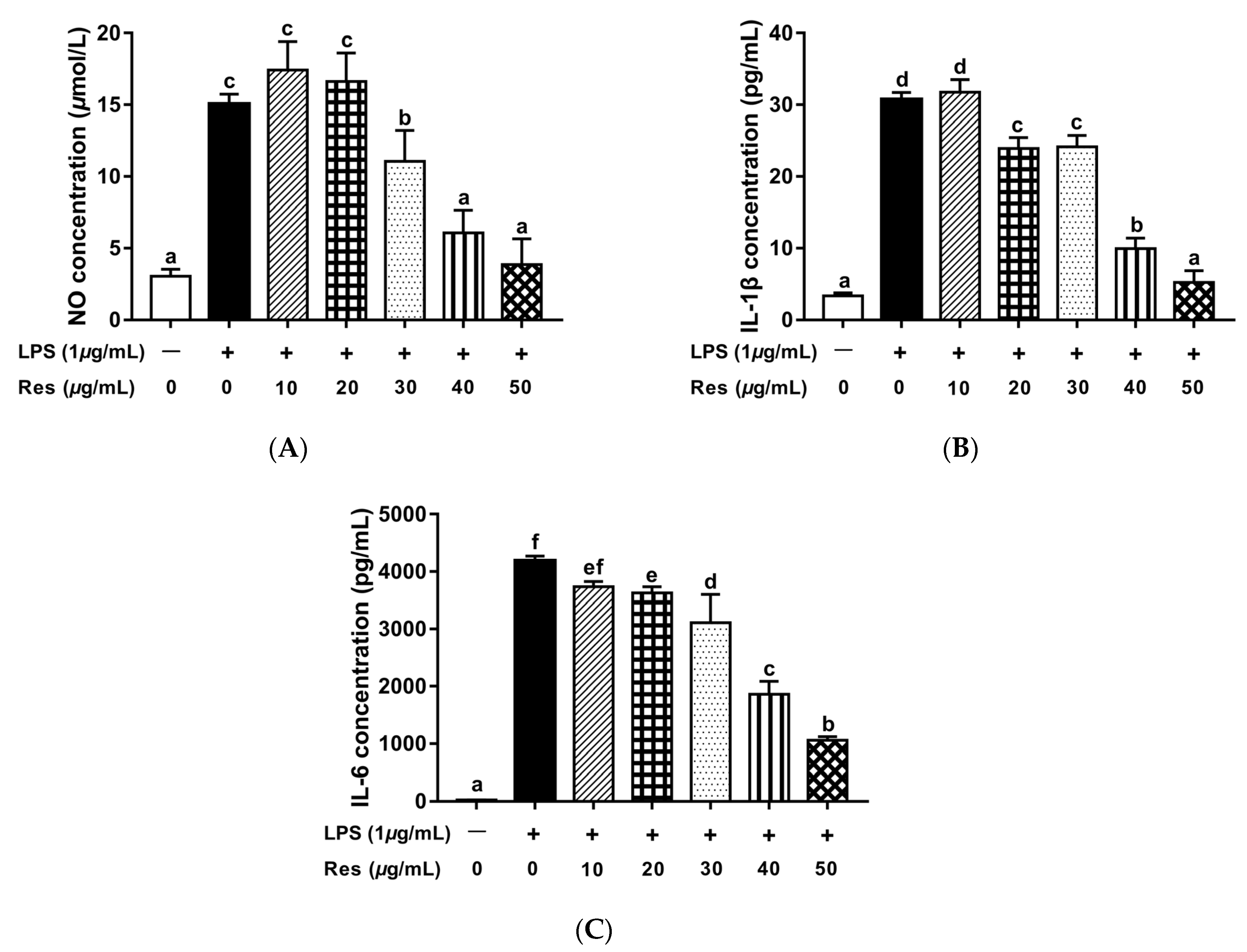
| Zein:Res (w/w) | State of the Dispersion | pH of the Dispersion | Z-Average (nm) | PDI | Zeta-Potential (mV) | Encapsulation Efficiency (%) | |||
|---|---|---|---|---|---|---|---|---|---|
| Before Lyophilization | Re-Dispersion | Before Lyophilization | Re-Dispersion | Before Lyophilization | Re-Dispersion | ||||
| 10:1 | uniform | 6.53 a ± 0.02 | 216.43 a ± 2.06 | 172.63 b ± 1.15 | 0.20 a ± 0.01 | 0.21 a ± 0.01 | −30.03 a ± 1.50 | −35.27 b ± 0.47 | 81.93 b ± 2.01 |
| 8:1 | uniform | 6.55 a ± 0.02 | 220.03 ab ± 2.89 | 171.23 b ± 4.69 | 0.18 a ± 0.01 | 0.23 a ± 0.03 | −30.70 a ± 0.26 | −37.87 a ± 0.42 | 80.14 b ± 3.69 |
| 6:1 | uniform | 6.64 b ± 0.01 | 219.90 ab ± 1.32 | 168.67 ab ± 1.66 | 0.19 a ± 0.01 | 0.23 a ± 0.02 | −29.93 a ± 0.57 | −38.87 a ± 0.55 | 73.54 b ± 3.77 |
| 4:1 | uniform | 6.57 a ± 0.02 | 221.00 ab ± 3.06 | 167.30 ab ± 1.06 | 0.20 a ± 0.02 | 0.24 a ± 0.02 | −30.33 a ± 0.67 | −35.83 b ± 0.42 | 58.90 a ± 1.99 |
Publisher’s Note: MDPI stays neutral with regard to jurisdictional claims in published maps and institutional affiliations. |
© 2021 by the authors. Licensee MDPI, Basel, Switzerland. This article is an open access article distributed under the terms and conditions of the Creative Commons Attribution (CC BY) license (https://creativecommons.org/licenses/by/4.0/).
Share and Cite
Liu, J.; Zhang, Y.; Liu, W.; Gao, B.; Yu, L. A Novel Zein-Based Composite Nanoparticles for Improving Bioaccessibility and Anti-Inflammatory Activity of Resveratrol. Foods 2021, 10, 2773. https://doi.org/10.3390/foods10112773
Liu J, Zhang Y, Liu W, Gao B, Yu L. A Novel Zein-Based Composite Nanoparticles for Improving Bioaccessibility and Anti-Inflammatory Activity of Resveratrol. Foods. 2021; 10(11):2773. https://doi.org/10.3390/foods10112773
Chicago/Turabian StyleLiu, Jiaping, Yaqiong Zhang, Wenwen Liu, Boyan Gao, and Liangli (Lucy) Yu. 2021. "A Novel Zein-Based Composite Nanoparticles for Improving Bioaccessibility and Anti-Inflammatory Activity of Resveratrol" Foods 10, no. 11: 2773. https://doi.org/10.3390/foods10112773





